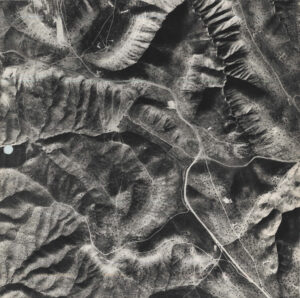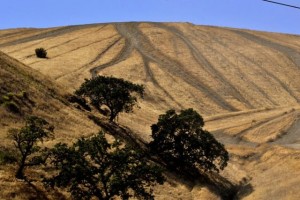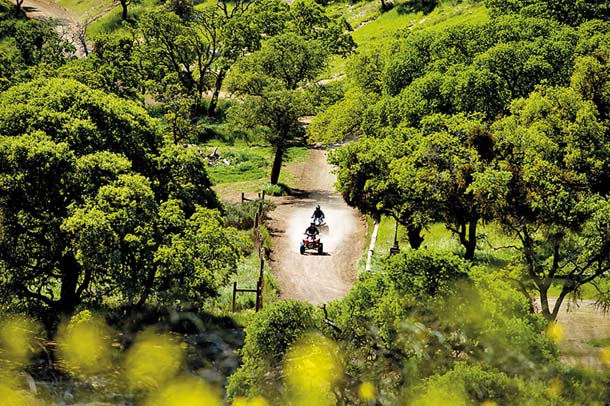.jpg)
Just over the hills southeast of Livermore, an arid valley called Corral Hollow runs east to the San Joaquin plain. In the early days of the Gold Rush, Corral Hollow was a part of a major thoroughfare from the San Francisco region to the southern Sierra. It has been the site of Native American occupation, explorers’ camps, travelers’ way stations, mining enterprises, a brick factory, a railroad, and a town—all gone now, leaving only subtle traces on the landscape. It is the home of a remarkable variety of plants and animals, bringing many desert-adapted species surprisingly close to East Bay cities. It has long provided opportunities for research and training in field biology. But it has also been the focus of land-use disputes in recent decades, pitting ranchers, residents, and biologists against off-road vehicle recreationists. Today that struggle is heating up again, and the fate of a precious natural resource for the Bay Area hangs in the balance.
Down from its headwaters, Corral Hollow Creek cuts a deep, rocky gorge. Debouching from its narrow canyon, the water slackens in a broad, nearly flat-floored valley, forming the first and northwesternmost segment of Corral Hollow proper. This quiet place, tucked into fold mountains south and east of Livermore, was chosen by coal miners in the 1850s, not only for digging but also as a place for their families to live. My own grandfather lived there with his parents at the turn of the 20th century. They called their town Tesla, and at one time numbered some 1,500 souls.
The vale of Tesla rests in the embrace of voluptuous hills. Quiet, still, secluded; animated by gentle breezes and enlivened by songs of meadowlark and quail. A high, north-facing ridge above the townsite holds great sweeps of blue oaks in a mosaic with groves of bright green buckeyes (the latter were my grandfather’s favorites). Other ridges embracing the valley are but thinly covered with soft grassland, showing to advantage the most seductive curves and folds. The valley floor, sheeted with terrace gravels, spreads an apron of rock washed from Franciscan highlands to the southwest. (The Franciscan assemblage forms the deep basement or underpinning for much of the coast ranges. It consists of marine rocks mostly from the age of dinosaurs, and it outcrops prominently in the city of San Francisco.) Among the gravels are very abundant cobbles and boulders of blue glaucophane schist, a stone that attracted Native American people of the coast ranges.
In addition to mining buildings, the town of Tesla had a hospital, Catholic church, general store, post office, school, hotel, saloon, sawmill, livery stable, butcher shop, dairy, two large bunkhouses, several neighborhoods of private homes, and cemeteries. This was not an insignificant community on the fringe of the civilized world. From 1902, when the Black Diamond mining district north of Mount Diablo went out of production, up until 1915, the Tesla coal mines supplied most of the coal used in the Bay Area?
Today it takes a historian’s or an archaeologist’s eye to recognize what remains of the once-thriving town. Perched on a south-facing slope well above the valley floor, a flat piece of ground marks the site of the little Catholic church built of redwood in 1901. Archbishop Riordan of San Francsico officiated at the church’s dedication, and a special train brought in 250 people from Stockton.
Now, a century after the dedication of the church, the town has left few visible traces, save flats where the buildings sat and a scattering of exotic trees (the customary tree-of-heaven, Chilean pepper, and eucalyptus; but also mesquite, a real oddity, probably imported from the southwestern U.S. as forage for domestic animals). The evidence of mining per se is more obvious. Huge spoil heaps and fluted scree slides descend from old mine portals. These lead to extensive tunnels, which burrow into the deep coal seams. The scree zones are nearly white, as is much of the bedrock that produced them.
Miners were not the first people to inhabit this valley. Important and sensitive Native American (likely either Yokuts or Ohlone) archaeological sites prove that Tesla was—and still is—a sacred precinct. In addition, bedrock mortars (used by the Native Americans for the grinding of acorns and other seeds) are conspicuous near the creek. Juan Bautista de Anza was perhaps the first European to intrude here, in April 1776, as he led a party through on his way back from San Francisco to Monterey, following a side trip to explore the San Joaquin Valley. Joaquin Murietta and Tiburcio Vasquez, not mythical figures but real bandidos, holed up in Corral Hollow, as did Grizzly Adams’ not the TV actor but the real man. In those days, grizzlies were common. Corral Hollow received its name from a corral, located well downstream from the Tesla site, used to detain wild mustangs in the 1850s. It was mustangs that drew Joaquin Murietta and his horse-wrangling compañeros to the area.
Corral Hollow is the northernmost long, deep, rocky valley in the arid south coast ranges (which run south from the Sacramento Delta). Descending into it over the pass from Livermore, one is immediately struck by its rocky, desertic character— a startling discovery so close to home.
Corral Hollow is famous to vertebrate biologists as the northernmost site for many reptiles and amphibians, including glossy snakes, black-headed snakes, and spadefoot toads. It is the home of San Joaquin coachwhips, Alameda whipsnakes, red-legged frogs, tiger salamanders, and horned lizards. It is also the playground of kit foxes. It is near the northern limit for two birds, the lesser nighthawk and phainopepla, and for another snake, the long-nosed. Classes from U.C. Berkeley, U.C. Davis, and CSU Hayward have been using Corral Hollow as a basic training ground in vertebrate biology for decades. Corral Hollow is also famous to botanists, because numerous plant species reach their northernmost limits there.
Environmental consultants (Jones and Stokes, San Jose) working recently at Tesla on state contract identified a remarkable diversity of native plants, including four kinds of larkspurs (Delphinium spp.); the graceful, cream-colored dwarf poppy (Meconella californica); a variety of rare members of the lily family, including mission bells (Fritillaria agrestis), peninsular onion (Allium peninsulare), and, most notably, the rare clay mariposa (Calochortus argillosus).
Some of the many wildflowers that adorn the area in spring are showy and hard to miss, like the two red paintbrushes (Castilleja foliolosa and C. applegatei ssp. martinii), or the blazing yellow wooly sunflower (Eriophyllum aff. jepsonii). Others are diminutive and require a careful search, like the lance-leaved thornmint (Acanthomintha lanceolata) or the California dwarf flax (Hesperolinon californicum), which blooms down in between dry grass stalks in the height of summer drought. There is, without doubt, much more to find, as the consultants were contracted to survey the project area for one year only and such short-term surveys can be gravely inadequate; many plant species are hard to find, and many may only appear in certain favorable years.
The trees of Corral Hollow are also quite interesting. The slopes about the mines support a scattering of ghost pine (Pinus sabiniana); a colony of bigberry manzanita (Arctostaphylos glauca), and an unusual population of blue oak (Quercus douglasii), with dark green leaves rather than the typical light blue. The combination of light rocks and conifers reminds one of the Sierra, surprising because this small patch of pines is very isolated, and surrounded by miles of open grassland characteristic of the dry west margin of the San Joaquin Valley. Moreover, the pines are lower in elevation than nearby oak woodland, the reverse of what one finds elsewhere in California: the ghost pines and blue oaks should be intermingled, or the pines should be higher in elevation. The reason for this anomaly may lie in the rocks. The bedrock is quartz-rich sandstone of the Eocene Tesla Formation, a nutrient-poor substrate similar to the Eocene quartz-rich sandstone north of Mount Diablo that supports isolated Coulter pines. The pines are evergreens and thus can do better on extreme substrates than the blue oaks, which must replace their foliage every year and require adequate levels of water and nutrients to do so.
The Tesla Formation harbors ancient plants, too. Fossil leaves from a subtropical forest can occasionally be found. The most impressive specimen I have seen is a fan palm frond, now housed in the University of California Museum of Paleontology at Berkeley. Fan palms have not grown this far north in over 20 million years.
Sycamores and Fremont cottonwoods grow in the gravels of the valley floor, as they characteristically do along streamcourses draining the hills all down the west side of the San Joaquin Valley. Backlit, the fluttering leaves of the cottonwoods glow brilliantly. In late spring or early summer, the branches are loaded with white fluff balls of downy seeds that catch the prevailing wind streams and sail down the hollow. The sycamores are seasoned veterans with white-barked trunks, each tree possessing unique character. Most have spreading branches like old oaks; some have branches twisted spirally around the trunk, as if the spirit had flown away in a whirlwind. Beneath the trees, the stream flows gently over stones, making sounds impossible to describe, perhaps recalling soft chuckling and the tinkling of wood chimes. The soul is conveyed to repose. This is no land that time forgot, but a backwater where palpable decay proceeds at a comforting pace.
But not for long. If the California Department of Parks and Recreation gets its way, Tesla and its surrounding hills will soon be an off-highway vehicle recreation area, an extension of the Carnegie State Vehicle Recreation Area (SVRA) several miles to the east. According to the proposed plan in the State’s “Final General Plan Amendment and Environmental Impact Report,” the area around and above the mine portals and ghost pines will be assigned to “multiple use” trails, recreational 4×4 roads, and a motorcycle/all-terrain vehicle (ATV) trail (although one alternative in the plan omits the motorcycle trail). The now-quiet track leading through the townsite along Corral Hollow Creek will become another “multiple use” trail, leading to a gate beyond which motorcycles would have access to some of the most remote, secluded, scenic, and historic open space remaining in the Bay Area. Both sides of the valley of Tesla will have the so-called multiple-use trails. (The EIR is unclear whether or not motorcycles and ATVs will be allowed on these trails, but the map laying out the proposal implies vehicular access for these trails as well as the path right up the center of the valley.)
This kind of use poses serious threats to both wildlife and non-motorized human enjoyment of the area. It is known that off-road vehicle (ORV) use increases erosion and siltation, which in the case of Corral Hollow could have impacts all the way down the canyon to the San Joaquin Valley. The siltation can lower water levels in pools that are required breeding habitat for red-legged frogs, spadefoot toads, and other amphibians. Such shallowing increases water temperature and decreases frequency of mating attempts and the amount of suitable escape-cover for these animals. Silt accumulates on algae, rendering it less available for larval food. In addition, ORVs can collapse rodent burrows where red-legged frogs, tiger salamanders, and spadefoot toads spend much of their time.
The state has proposed various mitigation measures to avoid or reduce siltation and other impacts on sensitive reptile and amphibian habitat, but most of these involve restricting ORVs to designated trails and stream crossings, a very difficult enforcement challenge.
There is also the matter of noise. The effects of ORV noise on human visitors are overwhelming, of course. While the state claims that this area will be open to all types of users, the ear-splitting noise of ORVs echoing across the canyon would essentially eliminate the possibility of the tranquil use sought by hikers and observers of wildlife. The potential effects of noise disturbance on wildlife in the area have not been studied, but could well include impacts on mating, feeding, and migration habits.
In light of such issues, the California Department of Fish and Game has registered its disapproval of the state park proposal, expressing particular concern about the inadequacy of proposed mitigations for impacts on wildlife and the plan’s lack of compliance with the California Environmental Quality Act (CEQA).
I stand overlooking this quiet valley, imagining my grand­father’s time here as a child, and I wonder where present and future residents of rapidly growing Livermore Valley—and the rest of the Bay Area—will go for peace and solitude.
The last time I visited Tesla, I lay in the grass, gazed at the clouds drifting serenely above, and imagined I was there with my grandfather and his parents. In the tranquility of Tesla today, it is easy to travel back in time and imagine the hollow as it was a century ago—crowded with rustic wood buildings, smoke rising from chimneys, wagons and carriages criss-crossing the flats, groups of children walking to school. Down by the stream I could hear children laughing, laughing . . . At length, the ubiquitous birdsong that fills the valley woke me gently from my reverie. What a disappointment it was to wake up remembering the present, and the serious threats now looming over Tesla. I noticed a lone golden eagle circling high above the valley, and it struck me that perhaps the raptor and I share a common plight, both of us seeing too far, too much.




